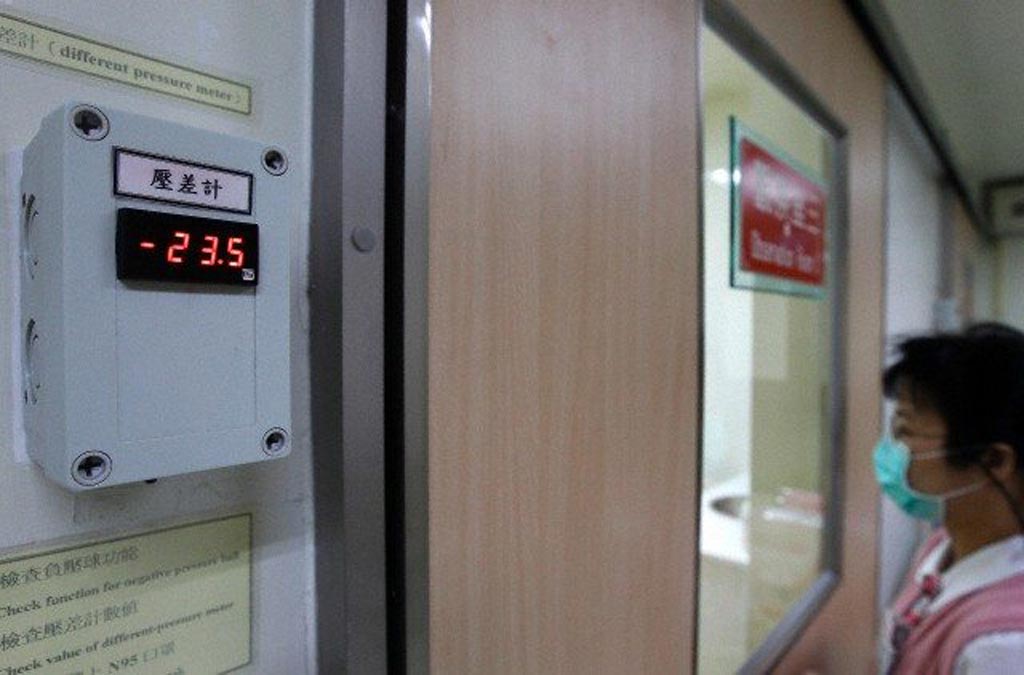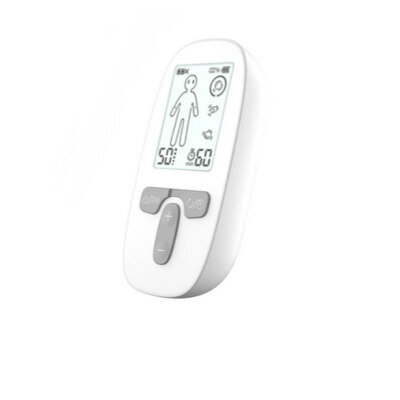High Negative Pressure Limits Dispersion of Airborne Contaminants
|
By HospiMedica International staff writers Posted on 24 Dec 2018 |

Image: An AIIR at Taipei City Hospital (Photo courtesy of Reuters/Corbis).
Maintaining a high negative pressure in hospital isolation rooms effectively limits the dispersion of airborne contaminants, according to a new study.
The study, part of a doctoral dissertation by a researcher at the University of Eastern Finland (UEF; Viestintä), was designed to determine the containment capability of hospital airborne infection isolation rooms (AIIRs) by measuring air change rates of the patient room and anteroom, pressure differences, contaminant removal, and contaminant transmission during door openings and human movement. The researchers used a tracer gas method to simulate the release of infectious agents from a patient.
The results showed that high air change rates do not ensure efficient removal of infectious agents in the breathing zone, but that local in AIIR airflow patterns are more important. Applying high mean negative pressure between the AIIR and the surroundings significantly limited particle transmission outside of the AIIR. But while an anteroom helped control particle transmission, the dilution was not effective enough, based on observed air change rates of the anterooms studied. The dissertation was presented at UEF on December 14, 2018, and published in the December 2018 issue of Annals of Work Exposures and Health.
“Generally, a healthcare worker does not stay in the anteroom more than 2–3 minutes, thus to achieve at least 90% contaminant removal, the minimum air change rate requirement of 40 liters per hour would be needed after entering the anteroom,” said dissertant Anna Kokkonen, MSc. “The findings of the present study can be utilized as a starting point when setting consistent negative pressure and ventilation design guidelines for contaminant containment.”
AIIRs are single-occupancy patient spaces designed to isolate airborne pathogens to a safe containment area. AIIRs are a specialized application of a hospital’s heating, ventilating, and air conditioning (HVAC) system, where the airflow supplied into the room is balanced with exhaust airflow to create negative differential pressure with respect to an adjacent space, usually the hallway or an anteroom, so that no airborne particulates escape into nursing staff or public areas. The exhaust air is expelled through dedicated ductwork to rooftop ventilation stacks, where atmospheric air provides sufficient dilution to make the resulting air safe.
Related Links:
University of Eastern Finland
The study, part of a doctoral dissertation by a researcher at the University of Eastern Finland (UEF; Viestintä), was designed to determine the containment capability of hospital airborne infection isolation rooms (AIIRs) by measuring air change rates of the patient room and anteroom, pressure differences, contaminant removal, and contaminant transmission during door openings and human movement. The researchers used a tracer gas method to simulate the release of infectious agents from a patient.
The results showed that high air change rates do not ensure efficient removal of infectious agents in the breathing zone, but that local in AIIR airflow patterns are more important. Applying high mean negative pressure between the AIIR and the surroundings significantly limited particle transmission outside of the AIIR. But while an anteroom helped control particle transmission, the dilution was not effective enough, based on observed air change rates of the anterooms studied. The dissertation was presented at UEF on December 14, 2018, and published in the December 2018 issue of Annals of Work Exposures and Health.
“Generally, a healthcare worker does not stay in the anteroom more than 2–3 minutes, thus to achieve at least 90% contaminant removal, the minimum air change rate requirement of 40 liters per hour would be needed after entering the anteroom,” said dissertant Anna Kokkonen, MSc. “The findings of the present study can be utilized as a starting point when setting consistent negative pressure and ventilation design guidelines for contaminant containment.”
AIIRs are single-occupancy patient spaces designed to isolate airborne pathogens to a safe containment area. AIIRs are a specialized application of a hospital’s heating, ventilating, and air conditioning (HVAC) system, where the airflow supplied into the room is balanced with exhaust airflow to create negative differential pressure with respect to an adjacent space, usually the hallway or an anteroom, so that no airborne particulates escape into nursing staff or public areas. The exhaust air is expelled through dedicated ductwork to rooftop ventilation stacks, where atmospheric air provides sufficient dilution to make the resulting air safe.
Related Links:
University of Eastern Finland
Latest Critical Care News
- Ingestible Capsule Monitors Intestinal Inflammation
- Wireless Implantable Sensor Enables Continuous Endoleak Monitoring
- Pulse Oximeter Index Offers Non-Invasive Guides for Fluid Therapy
- Wearable Patch for Early Skin Cancer Detection to Reduce Unnecessary Biopsies
- 'Universal' Kidney to Match Any Blood Type
- Light-Based Technology to Measure Brain Blood Flow Could Diagnose Stroke and TBI
- AI Heart Attack Risk Assessment Tool Outperforms Existing Methods
- Smartphone Imaging System Enables Early Oral Cancer Detection
- Swallowable Pill-Sized Bioprinter Treats GI Tract Injuries

- Personalized Brain “Pacemakers” Could Help Patients with Hard-To-Treat Epilepsy
- Microscopic DNA Flower Robots to Enable Precision Medicine Delivery
- Origami Robots to Deliver Medicine Less Invasively and More Effectively
- Improved Cough-Detection Technology Aids Health Monitoring
- AI Identifies Children in ER Likely to Develop Sepsis Within 48 Hours
- New Radiofrequency Therapy Slows Glioblastoma Growth
- Battery-Free Wireless Multi-Sensing Platform Revolutionizes Pressure Injury Detection
Channels
Surgical Techniques
view channel
Robotic Assistant Delivers Ultra-Precision Injections with Rapid Setup Times
Age-related macular degeneration (AMD) is a leading cause of blindness worldwide, affecting nearly 200 million people, a figure expected to rise to 280 million by 2040. Current treatment involves doctors... Read more
Minimally Invasive Endoscopic Surgery Improves Severe Stroke Outcomes
Intracerebral hemorrhage, a type of stroke caused by bleeding deep within the brain, remains one of the most challenging neurological emergencies to treat. Accounting for about 15% of all strokes, it carries... Read morePatient Care
view channel
Revolutionary Automatic IV-Line Flushing Device to Enhance Infusion Care
More than 80% of in-hospital patients receive intravenous (IV) therapy. Every dose of IV medicine delivered in a small volume (<250 mL) infusion bag should be followed by subsequent flushing to ensure... Read more
VR Training Tool Combats Contamination of Portable Medical Equipment
Healthcare-associated infections (HAIs) impact one in every 31 patients, cause nearly 100,000 deaths each year, and cost USD 28.4 billion in direct medical expenses. Notably, up to 75% of these infections... Read more
Portable Biosensor Platform to Reduce Hospital-Acquired Infections
Approximately 4 million patients in the European Union acquire healthcare-associated infections (HAIs) or nosocomial infections each year, with around 37,000 deaths directly resulting from these infections,... Read moreFirst-Of-Its-Kind Portable Germicidal Light Technology Disinfects High-Touch Clinical Surfaces in Seconds
Reducing healthcare-acquired infections (HAIs) remains a pressing issue within global healthcare systems. In the United States alone, 1.7 million patients contract HAIs annually, leading to approximately... Read moreHealth IT
view channel
Printable Molecule-Selective Nanoparticles Enable Mass Production of Wearable Biosensors
The future of medicine is likely to focus on the personalization of healthcare—understanding exactly what an individual requires and delivering the appropriate combination of nutrients, metabolites, and... Read moreBusiness
view channel
Philips and Masimo Partner to Advance Patient Monitoring Measurement Technologies
Royal Philips (Amsterdam, Netherlands) and Masimo (Irvine, California, USA) have renewed their multi-year strategic collaboration, combining Philips’ expertise in patient monitoring with Masimo’s noninvasive... Read more
B. Braun Acquires Digital Microsurgery Company True Digital Surgery
The high-end microsurgery market in neurosurgery, spine, and ENT is undergoing a significant transformation. Traditional analog microscopes are giving way to digital exoscopes, which provide improved visualization,... Read more
CMEF 2025 to Promote Holistic and High-Quality Development of Medical and Health Industry
The 92nd China International Medical Equipment Fair (CMEF 2025) Autumn Exhibition is scheduled to be held from September 26 to 29 at the China Import and Export Fair Complex (Canton Fair Complex) in Guangzhou.... Read more














